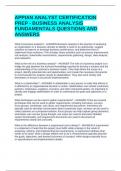APPIAN ANALYST CERTIFICATION
PREP - BUSINESS ANALYSIS
FUNDAMENTALS QUESTIONS AND
ANSWERS
What is business analysis? - ANSWER-Business analysis is the practice of analyzing
an organization or a business domain to identify a need or an opportunity, suggest
solutions to improve or leverage business performance, and determine how to
implement those solutions. This includes many activities such as process improvement,
risk analysis, stakeholder assessments, requirements gathering, design, data analysis,
and evaluation.
What is the role of a business analyst? - ANSWER-The role of a business analyst is to
bridge the gap between the technical knowledge required to develop a solution and the
understanding of the customer's business needs. They help define the scope of a
project, identify potential risks and opportunities, and create the necessary documents
to communicate the analysis results to stakeholders. They also work closely with
developers to ensure a successful implementation.
What is a stakeholder? - ANSWER-A stakeholder is any person or entity that affects or
is affected by an organizational decision or action. Stakeholders can include customers,
partners, employees, suppliers, investors, and other interested parties. It's important to
identify and engage stakeholders in order to understand the goals and objectives of a
project.
What techniques can be used to gather requirements? - ANSWER-There are several
techniques that can be used to gather requirements, including interviews, surveys,
focus groups, workshops, use cases, and requirement documents. Interviews are
typically used to stimulate conversation about a particular topic, surveys can be used to
collect opinions on a proposed solution, focus groups can help capture group dynamics,
workshops can uncover group thought, use cases are used to document detailed
system functionality, and requirement documents are used to document all
requirements clearly and concisely.
What is the difference between a requirement and a design? - ANSWER-A requirement
is a statement of need that the project must fulfill, while a design is the result of
analyzing, refining, and implementing the requirements. A requirement defines what
needs to be done, while a design details how to do it. Requirements typically describe
the goals, objectives, and desired outcomes of a project, while designs typically focus
on specifications and implementation details.
, What is a process? - ANSWER-A process is a set of activities that are performed in
order to achieve a goal.
What is a use case? - ANSWER-A use case is a specific set of activities that are
required in order to complete a task or achieve a goal.
What is the purpose of a stakeholder analysis? - ANSWER-The purpose of a
stakeholder analysis is to identify, assess, and manage the expectations and
requirements of stakeholders in order to ensure that the project meets their needs and
expectations.
What is the difference between process improvement and process optimization? -
ANSWER-Process improvement is the process of making a process more effective or
efficient by modifying or eliminating steps or activities. Process optimization is the
process of finding the most efficient or cost-effective way to complete a process.
Process improvement focuses on the internal operations of an organization, while
process optimization focuses on external factors that could be impacting the
effectiveness and efficiency of a process.
What is the purpose of risk analysis? - ANSWER-The purpose of risk analysis is to
identify, assess, and prioritize risks that could potentially prevent the successful
completion of a project. It involves analyzing risk factors such as economic conditions,
technology, political influences, and competition in order to estimate how a project might
be impacted. Risk analysis helps organizations plan for the unexpected so they can
take proactive steps to reduce the likelihood of failure.
What is the difference between the rational and the flexible approaches to decision-
making? - ANSWER-The rational approach to decision-making involves analyzing the
available data and making an informed decision. This often requires substantial analysis
and research, and decisions are usually based on facts and objectives. The flexible
approach involves weighing the pros and cons of each decision and requires
considering more subjective criteria. This allows for greater creativity and flexibility when
making decisions.
How can data analysis be used to improve decision-making? - ANSWER-Data analysis
can be used to identify trends, correlations, and patterns that can help inform decisions.
By understanding how certain decisions or actions might affect the outcome of a project,
organizations can make data-driven decisions that are more likely to result in successful
outcomes. Data analysis allows for the evaluation of multiple scenarios in order to
identify the optimal solution.
What is the role of prototyping in software development? - ANSWER-Prototyping is a
model or simulation of a proposed software solution. It allows developers and
stakeholders to test out ideas and experiment with different approaches to a problem.
This helps identify potential flaws in the design or any areas that need to be refined, so
that changes can be made before the software is actually developed.




